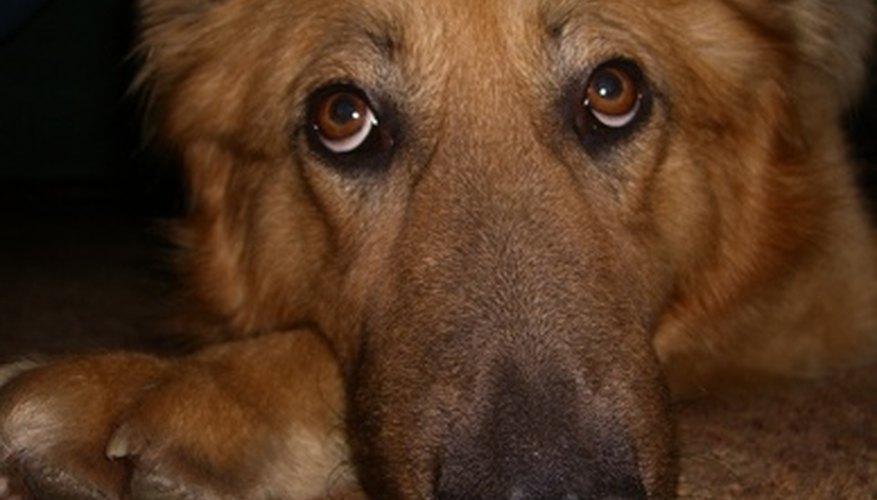Spay surgery is one of the most common procedures performed in small animal clinics, animal shelters and animal control agencies all over the world every day. It's an important operation that helps cut the risk of certain types of cancers, reduces behavioural problems and assists in the control of pet overpopulation. But according to InfoVets, an online veterinary informational resource run by veterinarians, spay is not a simple surgery and "demands great skill and attention on the part of the surgeon." So alert owners should be on the lookout for signs of post-surgical complications, and diarrhoea is one such sign.
What is Spay?
People have their dog spayed for a variety of reasons. The procedure cuts the risk of deadly infections like pyometra and cancers that affect the breast, ovaries and uterus; it stops certain behavioural problems such as roaming, aggression and anxiety; and lessens the affects of hormonal disorders that aggravate diabetes or epilepsy.
The operation involves putting the dog under anaesthesia, making a small incision, removing the uterus and ovaries, and suturing the incision. The whole procedure typically takes about 15 minutes. Once the dog has had the surgery, she has been "spayed."
- People have their dog spayed for a variety of reasons.
- The operation involves putting the dog under anaesthesia, making a small incision, removing the uterus and ovaries, and suturing the incision.
The entire experience can be upsetting to sensitive dogs, and emotional diarrhoea is not uncommon in such dogs.
Spay Complications
According to the Animal Health Channel, most of the complications of spay surgery will occur as a result of a problem with anaesthesia. Overweight or pregnant animals, or bitches in heat, present special problems because of increased fatty tissue and blood supply to the area.
Later complications may include licking or biting at the incision and sutures, minor swelling, redness and tenderness at the site, and infections secondary to the dog licking her stitches. Diarrhoea is a complication that is more related to the dog's state of mind, or to the medications given to her to control pain and infection.
- According to the Animal Health Channel, most of the complications of spay surgery will occur as a result of a problem with anaesthesia.
- Diarrhoea is a complication that is more related to the dog's state of mind, or to the medications given to her to control pain and infection.
Possible Post-Surgical Diarrhea Causes
Some dogs go home with pain medications, usually included in a class of drugs commonly known as NSAIDs, or non-steroidal-anti-inflammatory drugs. These drugs help to control inflammation that is caused by trauma to the tissue, as happens with an incision. According to PetsWebMD, many of these drugs cause vomiting and diarrhoea in sensitive stomachs. Prophylactic antibiotics--that is, antibiotics given after surgery to guard against infection--are also known to produce stomach upset.
- Some dogs go home with pain medications, usually included in a class of drugs commonly known as NSAIDs, or non-steroidal-anti-inflammatory drugs.
- According to PetsWebMD, many of these drugs cause vomiting and diarrhoea in sensitive stomachs.
Diarrhoea can also be caused by emotional upset. From the time a dog is brought into the hospital through her recovery process, she can suffer from anxiety and extreme nervousness. This, too, contributes to an upset stomach which in turn causes diarrhoea.
Diarrhoea Defined
Diarrhoea is a widely used term that usually means a collection of related symptoms. Typical diarrhoea involves watery, loose stools that can vary in colour from yellowish-green to tarry and black. It smells rancid or foul, and can appear foamy, jelly-like or watery. The variation of diarrhoea is dependent upon the cause. For example, diarrhoea caused by a bacterial infection will be foamy, but if it is caused by a lack of bile, it will appear pale and pasty.
- Diarrhoea is a widely used term that usually means a collection of related symptoms.
- Typical diarrhoea involves watery, loose stools that can vary in colour from yellowish-green to tarry and black.
Diarrhoea Remedies
Diarrhoea in dogs is controlled in a way that is similar to humans. You should offer plenty of water so that your dog does not become dehydrated. Food should be withheld for at least 24 hours in order to rest the digestive tract. Pedialyte, available in grocery stores, is helpful to replace electrolytes. Low-sodium bullion cubes may make water more palatable to your dog. Once she has been diarrhoea-free for 24 hours, you may introduce small quantities of low-fat foods such as rice, eggs, pasta and cottage cheese.
- Diarrhoea in dogs is controlled in a way that is similar to humans.
- You should offer plenty of water so that your dog does not become dehydrated.
PetWebMD advises that you call your veterinarian if diarrhoea persists beyond 24 hours, if the stool contains blood or has a black, tarry appearance, and in the presence of a fever, lethargy and vomiting.
